How to prune grapes for the winter to collect large bunches?
For many centuries, people have known about such a wonderful berry as grapes, but the very pruning of grapes for the winter came to us relatively recently. The inhabitants of the planet Earth came up with such a technology of care only a few hundred years ago thanks to an ordinary donkey, and it happened in Ancient Rome.
Content
The benefits of pruning for the winter
The grapes themselves become more delicious thanks to pruning for the winter. The winegrowers of Ancient Rome have learned this lesson for themselves a long time ago. This technology began to spread to other countries and developed rapidly. Today, grape pruning can significantly increase its yield.
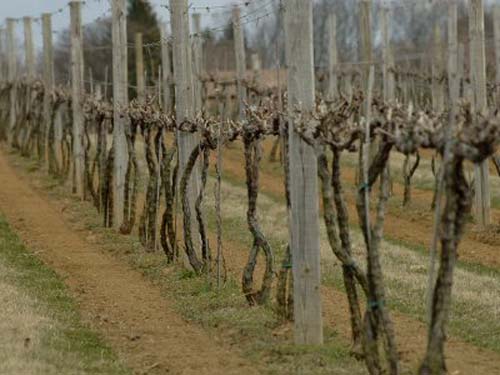
In addition, this technology allows you to control the growth of bushes, excluding their overgrowth. When to prune grapes for the winter has a positive effect on the ease of caring for them. She is able to make the fruits much tastier and more accessible during harvest.
If the gardener decides to shelter the grapes from negative factors in the form of strong gusts of wind, then pruning should be carried out in the autumn.
This is justified by the possibility of facilitated care of the bushes, a significant increase in their protection before the coming frosts, and by the onset of autumn, the number of fruits increases significantly.
The decision to prune the bushes in the spring is completely disastrous, since wounds caused by various factors in the cold seasons are difficult to heal. Cutting the vine in the initial place of sap flow will lead to the appearance of the so-called "tears", which has every chance to soon destroy the plant or, at best, reduce future yield.
You can prune grapes already in March, provided that the ambient temperature is not lower than five degrees Celsius. In this case, it is necessary to prune very carefully, and only those young bushes that have not entered into fruiting. You can also prune seedlings planted in autumn.
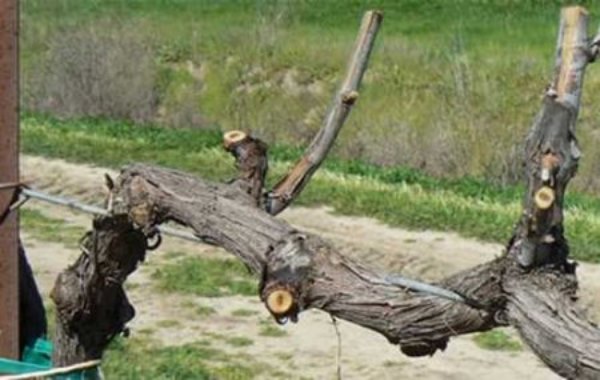
When it comes to pruning in the summer, it is difficult to call it pruning, as such, and although it would seem that winter is far away, it is necessary to prepare for it in advance. During this period, it is necessary to clear the bushes of diseased and unnecessary branches, mint, pinch and pinch the shoots on them, but it is necessary to cut it very carefully. This is a kind of prevention of diseases, the result of which is not only an improvement in the health of the bushes and an increase in the level of air intake, but also an increase in the level of lighting, which allows you to get excellent grapes as a result.
In the summer, such a kind of preventive pruning of bushes also becomes the result of facilitating the flow of nutrients to their key parts. Killing unneeded branches opens up more space for healthy branches that will grow by next year. In addition, you should not be afraid to slightly reduce and thin out the number and density of leaves. This will allow the bunches to develop and breathe properly.
All of the above makes it firmly clear that pruning grapes before the winter period is an important stage in caring for its bushes. The only thing a novice gardener needs to know about this issue is how to properly carry out the pruning itself.
There are many ways, and much also depends on the period of the year itself and on how old or young the grapes are.
Step-by-step pruning instructions
In the case of autumn pruning, it is best to do it in two stages, which will make sure that the best, in terms of fruiting, vines will survive until next year.This is one of the ways to prune grapes for the winter:
- The first stage begins after harvest. It consists in cleaning the bushes from those branches that have already passed the fruiting stage, from tops and weak shoots that impede the further normal and uniform development of grapes.
- The second stage, which marks the main circumcision, should begin a couple of weeks after the leaves fall, that is, before the entire vineyard is sheltered. By that time, a certain amount of carbohydrates in young shoots will go to the roots. When the harsh winter comes and some of the vines on the trellis suffer from frost - do not worry, as this will harden them in the fight against low temperatures. Do not forget that the bushes should be cut at a temperature of at least three degrees Celsius, otherwise the weakness of the branches is inevitable.
When the time comes for the need to prune young seedlings, it is unlikely that significant difficulties will arise in the process. Of course, this is provided that every year unnecessary shoots are regularly removed and, with the help of the gardener, the grapes form a certain, most convenient for him, bush shape, as a result of which there are three to eight original "sleeves" that will bear fruit in the future. If we are talking about more mature bushes, then you will need to tinker with them a little longer.
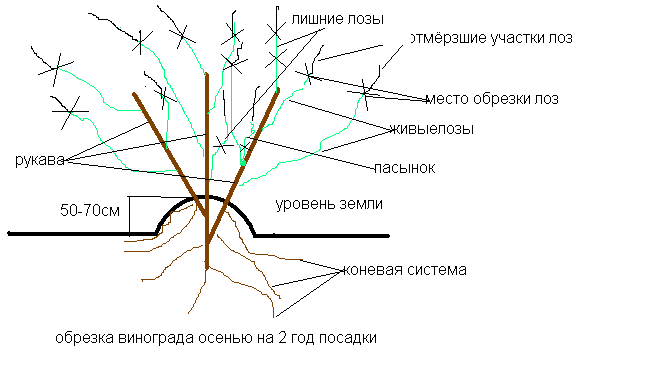
Despite the neglect of the condition of the bushes, when pruning grapes for the winter seems to be a matter of exorbitant difficulty, there are already prepared pruning schemes, so that even a "green" gardener will be able to carry it out without problems. The bushes should be pruned as follows:
- With the onset of the first decade of September, perennial sleeves should be cleaned of young shoots that have appeared before the first wire, which is located at a height of fifty centimeters above the ground.
- Those shoots that have grown on the sleeves above the level of the next wire (it should be at a distance of about thirty centimeters from the first wire) should be measured and the top, along with all the side stepsons, should be cut off by 10% of their length. Since winter does not spare anyone, you should first familiarize yourself with the detailed pruning schemes. Thus, one picture or two will help preserve the whole crop.
- With the arrival of mid-October, it is time to select some of the most developed shoots, located at the height of the aforementioned both wires.
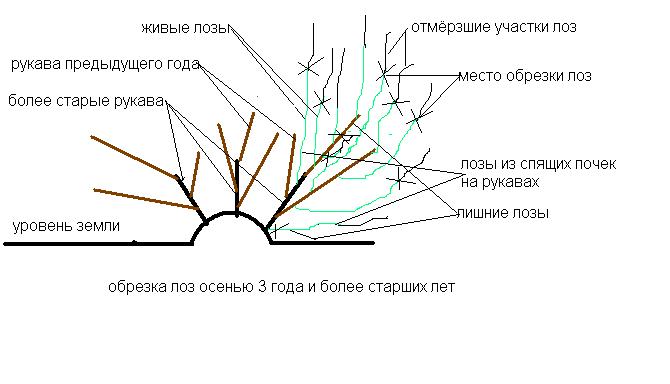
- Want some delicious, well-groomed grapes? Then the next step is to trim the very bottom shoot that has grown from the outside of the sleeve. It should be trimmed so that a few eyes remain. The work done at this stage will be the result of the creation of the so-called replacement knot.
- The last step is the formation of a fruit arrow, after which no winter will be terrible for the grapes. Cut off the shoot that is higher on the other side of the sleeve. The very number of eyes should reach the diameter of this shoot, but one more additional pair and the grapes will not face the problem of damping and freezing.
Such a scheme will allow only the most persistent and fruiting boles to remain, which are called branches perpendicular to the ground. So that winter does not bring unwanted surprises to the vineyard, the following steps should be the final steps to complete preparations for the upcoming meeting:
- Those branches that remain should be removed from the trellis and placed in the direction in which the vine grows.
- Fix them on the ground in any convenient way, and now winter is practically defeated.
Many novice winegrowers are sometimes interested in the question: when to prune grapes for the winter. For experienced vineyard owners, this also means leaving a few buds on the replacement knot and a dozen buds directly on the fruit frog. In fact, this is mostly a banal safety net, since winter is just around the corner.Another reason is that such seemingly extra buds, in the spring, make it possible to understand which shoots have sheltered the most lush inflorescences of grapes, before completely protecting the bushes from unnecessary green shoots.
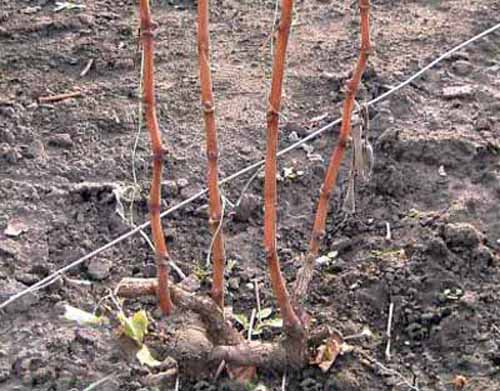
Returning to the fruit arrow and to the ten buds on it, the need for them is explained very simply. All the salt is that they are formed mainly in June, and this month the temperature is quite low. From the first to the seventh bud, the inflorescences are medium, but by the thirteenth (maximum to the fifteenth) bud, the largest inflorescences are obtained, which will finally form around July. It is in this month that there is enough sunshine for the grapes and the air temperature is also acceptable.
Pruning is difficult and should be done very carefully and carefully to avoid unwanted damage to the bushes.
Video "Pruning grapes for the winter"
Video clip about pruning of one-year, two-year and three-year grapes; shelter of grapes for the winter.
